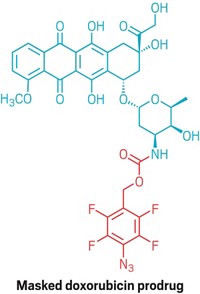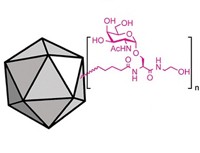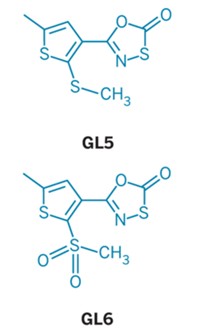Advertisement
Grab your lab coat. Let's get started
Welcome!
Welcome!
Create an account below to get 6 C&EN articles per month, receive newsletters and more - all free.
It seems this is your first time logging in online. Please enter the following information to continue.
As an ACS member you automatically get access to this site. All we need is few more details to create your reading experience.
Not you? Sign in with a different account.
Not you? Sign in with a different account.
ERROR 1
ERROR 1
ERROR 2
ERROR 2
ERROR 2
ERROR 2
ERROR 2
Password and Confirm password must match.
If you have an ACS member number, please enter it here so we can link this account to your membership. (optional)
ERROR 2
ACS values your privacy. By submitting your information, you are gaining access to C&EN and subscribing to our weekly newsletter. We use the information you provide to make your reading experience better, and we will never sell your data to third party members.
Biological Chemistry
Science Concentrates
July 26, 2004
| A version of this story appeared in
Volume 82, Issue 30
A new study offers another potential focus of drug development for tuberculosis. At the University of California, Berkeley, Carolyn R. Bertozzi and coworkers have discovered the enzyme in Mycobacterium tuberculosis that initiates the biosynthesis of the glycolipid called sulfolipid-1. This glycolipid is abundant on the outer envelope of those bacteria and is believed to be a virulence factor. It consists of the disaccharide trehalose elaborated with four lipids and a critical sulfate group. The first committed step in the biosynthesis of sulfolipid-1 is the sulfation of trehalose to trehalose-2-sulfate (structure shown). The researchers show that this step is mediated by a sulfotransferase called Stf0 [Nat. Struct. Mol. Biol., published online July 18, http://dx.doi.org/10.1038/nsmb802]. The researchers have solved the structure of Stf0, which reveals the molecular basis of trehalose recognition. They also find that Stf0 prefers unmodified trehalose as a substrate and that minor structural modifications of trehalose significantly reduce the enzyme's activity.
Asteroids, not comets, in Eocene
Thirty-five million years ago, during the late Eocene, Earth was bombarded with objects that left two massive craters: the Popigai crater in Siberia and the Chesapeake Bay crater off the coast of Virginia. Popular theory holds that comets originating outside of the solar system were responsible, in part because the craters' formation coincides with an increased blanketing of Earth by interplanetary dust particles. But now, Philippe Claeys at the University of Brussels and Roald Tagle at the Museum of Natural History in Berlin report evidence that the crater-forming objects were actually asteroids [Science, 305, 492 (2004)]. They analyzed rocks from the Popigai crater and found the rocks were enriched in platinum group elements in a concentration pattern characteristic of chondrites. Such meteorites are unlikely to originate from outside the solar system. The authors hypothesize that a giant collision of asteroids in the asteroid belt produced the meteorites and dust that together fell to Earth. The next step will be to test the rocks in the Chesapeake Bay crater.
Quantum dots target, image cancer cells
Quantum dots can be used for simultaneous targeting and imaging of cancer cells in live animals, according to a new study. A team led by Shuming Nie of Georgia Institute of Technology and Emory University developed quantum dot (nanocrystal) probes that target and image human prostate cancer cells growing in mice [Nat. Biotechnol., published online July 18, http://dx.doi.org/10.1038/nbt994]. The probes consist of quantum dots with a cadmium selenide (CdSe) core and a zinc sulfide (ZnS) shell. The quantum dots are coated with a self-assembling layer of an amphiphilic triblock polymer. The polymer has two hydrophobic blocks (polybutylacrylate and polyethylacrylate), one hydrophilic block (polymethacrylic acid), and a hydrophobic eight-carbon side chain. The quantum dots passively accumulate in the tumors via leaky blood vessels that supply tumors. The researchers can also actively target the tumors by decorating the surface of the probes with antibodies that bind to tumor-specific antigens.
One-pot enzyme encapsulation in silica matrix
A biosilification reaction that occurs naturally in diatoms has been employed to entrap enzymes in a mechanically stable silica matrix. Rajesh R. Naik at the Air Force Research Laboratory in Dayton, Ohio, and coworkers used a one-pot procedure to immobilize catalase and horseradish peroxidase inside a network of large aggregates of fused silica particles [Chem. Commun., published online July 7, http://www.rsc.org/is/journals/current/chemcomm/ccadvarts.htm]. The encapsulated enzyme can be stored in a dry state for several days without loss of activity. The entrapment process, which is carried out at neutral pH and room temperature, is quick and scalable for potential commercial applications in biocatalysis and biosensors, according to Naik. It employs a synthetic peptide mimic of a natural peptide from diatoms to condense water-soluble silicic acid into the silica particles. Magnetic nanoparticles can be encapsulated along with the enzyme in the one-step process, allowing the catalytically active silica matrix to be magnetically separated from the reaction product and recycled, Naik says.
My C-glycoside can beat your O-glycoside
By changing one atom (asterisk) in a promising bioactive agent--thus converting it from an O- to a C-glycoside--a research team has boosted the compound's potency by two to three orders of magnitude. A Kirin Pharmaceuticals compound called KRN7000 is an analog of ceramide O-glycosides isolated by Kirin researchers from a marine sponge. It shows immunostimulatory activity against cancer, malaria, diabetes, tuberculosis, trypanosomiasis, and other diseases--an extraordinary range of action that has inspired extensive studies of the compound. Because O-glycosides are enzymatically labile at the glycosidic link and C-glycosides are not, Richard W. Franck of City University of New York's Hunter College, Moriya Tsuji of New York University School of Medicine, and coworkers synthesized and tested a C-glycoside version of KRN7000. In mouse models, the C-glycoside's immunostimulatory activity turned out to be 100 times higher against melanoma and 1,000 times higher against malaria than that of KRN7000 [Angew. Chem. Int. Ed., 43, 3818 (2004)]. "We are working on making further C-glycoside analogs with the aim of obtaining more powerful and more selective immunostimulants," Franck says.






Join the conversation
Contact the reporter
Submit a Letter to the Editor for publication
Engage with us on Twitter